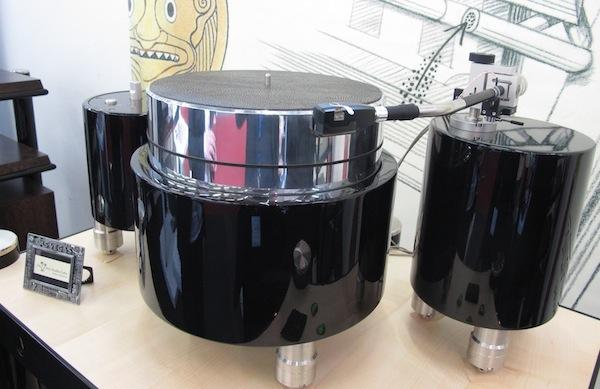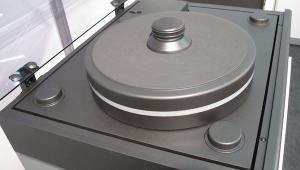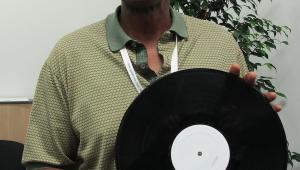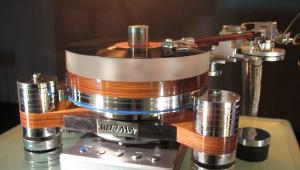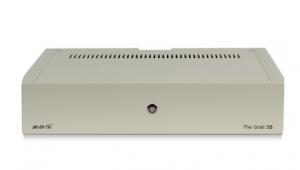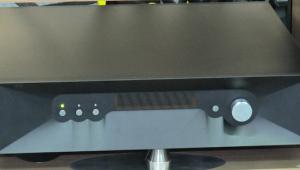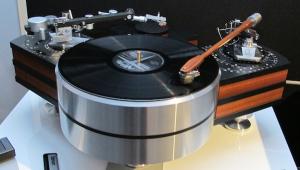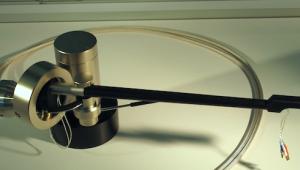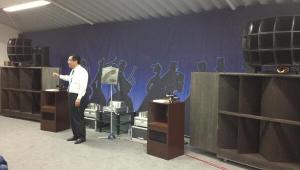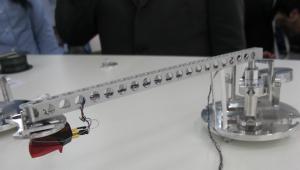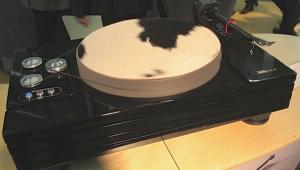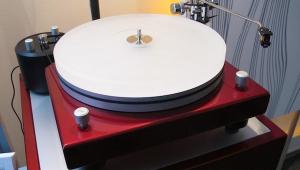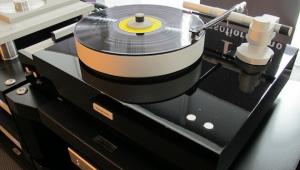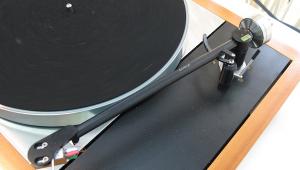Now, I just have to say something about a word we all know, and its called 'OVERKILL'. Now I'm sure this polished moonshine still will deliver something stellar by way of vinyl playback, but it just defies logic on a consumers basis. I feel embarrased when I look at the price tag, and maybe even a tad bit ashamed...
Da Vinci Audio's AAS Gabriel MK2 Reference Turntable and Master Reference Tonearm Virtu
However, this does not appear to be an innovative design. Rather its claimed high performance is based upon its precision build and there's nothing wrong with that!
The tonearm is the Master Reference Tonearm Virtu. As with the turntable, the design does not appear to be innovative but rather appears to be an ultra-refined version of a standard gimbaled design. However, refinement is as important as innovation.
While this arm has been declared by some as "state of the art" and I'm sure the all important bearings are of the highest quality, my take is that any tone arm featuring a '60s era SME-type locking collet head shell design must be disqualified from "state of the art" status. Such a head shell termination, while convenient, losses a considerable amount of rigidity and that by definition must to some degree limit its performance.
Still, you won't find a more beautifully turned out turntable built to ultra-high Swiss standards.
- Log in or register to post comments


Hi M.: You said: " locking collet head shell design must be disqualified from "state of the art" status. Such a head shell termination, while convenient, losses a considerable amount of rigidity and that by definition must to some degree limit its performance. "
Rigidity? How is that? all depend the arm wand kind of materials used and the right quality of the headshell and the collect. Even a removable headshell tonearm can help to change the tonearm it self frequency resonances against a continous arm wand.
Perhaps the real " detriment " on the sound quality could comes from the additional pin connectors inside/outside the headshell and that the cartridge output to tonearm output wire is not continuous.
I imagine/supose that the gentleamns that said the Virtu is a " state of the art " design said it because they made comparisons against other state of the art tonearm designs about the quality level sound performance.
It's not easy to qualify an audio product like a tonearm as a state of the art design because exist at least three " parameters " to measure it: 1- if the tonearm desing is in reality a " state of the art " because the design and its quality excution. "- if its sound quality performance is state of the art and 3- who test it and how was tested refered to: audio system, other tonearms comparisons in the same system and the reviewer sound/music priorities.
I never had the oportunity to test the Virtu but IMHO I can't to accept or to said that because of what you said is desqualified to be a state of the art design.
Only and opinion. Kind regards.

Dear M.: As both of us said: are only opinions.
State of the Art or not IMHO what define the overall quality performance of an audio item is: the sum of the parts that at the end is what really defines that quality level performance.
I never read a scientific test where the " old fashion " collet design was desqualified as a " good " part of any tonearm design. How can we prove that that " collect design " is a wrong design " per se "?
I can do it. Can you?
As I said the " worst " thing in that kind of tonearm design is in the non continuous cartridge to to tonearm output wires.
Maybe you have to check " state of the art " tonearm designs as the Technics EPA 100-MK2 mated with the right cartridge and after you cange the internal wires of this vintage design.
I think that in Audio as in the life does not exist the " absolute " but all is " relative ". Don't you think?
Greetings.

Dear M.: Probably the issue is that does not exist a precise, qualified and universal definition of " State of the Art " in Audio and the definition of that term on each link in the Audio System Chain.
It's obvious that for you that kind of collet design in a tonearm could not be on that State of the Art definition and nothing wrong with that but IMHO we need that Universal/precise/qualified, each audio product, State of the Art definition because today " everyone " has its own and very personal definition that at the end just means almost nothing.
IMHO some one must join together: reviewers, audio distributors, Audio System owners/Consumers, designers, manufacturers, etc. to achieve those audio items definitions. I think is necessary to do it: don't you think?
Greetings.

Dear M.: How can i tell what I need to tell?, I think that with the appropiate words: you are a well regarded reviewer and it's disappointing that you ( as other reviewers. ) decided don't take a compromise in an audio missue that you are supporting here and it's disappointing because all of us " simple mortals " want to learn and want to learn from the " experts " and I think that you as any other reviewer have a serious responsability with any of us that want to learn and grow up and that are asking something in any audio subject.
So, here I go again: Can I ask you to define the State of the Art characteristics in a tonearm?
Again, thank's in advance and kind regards. Appreciated your answer.

Dear M.: Thank's for your answer and I would like to make some comments on the whole subject:
Yes the SOTA tonearm must be rigid the question here could be: how much? you said " extremely " that's IMHO is something not precise and I think there is no single scientific information that can answer my question about. At least I don't know nothing about rigidity on tonearms other that has to be rigid.
" Its mass should be sufficiently high.... ", well I think that must be the necessary to cope with the necesities of any single cartridge and not only low/medium compliance ones. I think that a SOTA tonearm has to be " universal ".
" ..by disadvantages related to moment of inertia and less rigidity. So I think a 9" arm correctly designed is "state of the art"."
Well, IMHO a pivoting tonearm could has SOTA status independent of its effective length. The length is only a part on the whole design and from my point of view can determine is SOTA or not status.
Due to my experiences with many type of tonearms through several years ( not so wide like yours. ) I think that the only type of tonearm that can reach SOA status is a gimbaled one: not unipivots or LT. At least of what exist on the market.
" be fabricated from a 'state of the arm" material such as a composite car..."
This could be very complex to choose a build material. Perhaps the best we can hope is that the SOTA tonearm be builded with the blend of materials that puts on that overall performance status.
" computer-designed in terms of vibrational characteristics and control so it's behavior is known before construction. "
That is more easy to say it that to do it. IMHO the final behavior depends ( primary/mainly. ) on the tonearm/cartridge couple figure where does not exist two similar/same cartridges that has same real characteristics, not even two samples of the same model performs identical.
These are my comments about and in the other issues I 'm with you.
Two characteristics that must have a SOTA tonearm is that should be " user friendly " and that the internal wiring and connectors be SOTA ones.
It's obvious that the execution of the tonearm design has SOTA quality as its in play performance.
Maybe exist other importants atributes about but at the end this is only my opinion where I'm not saying you are wrong or right but only my amateur/audiophile opinion.
Again thank's for your answer and if you want to enhance it will be as always: apreciated.
Greetings,
R.
